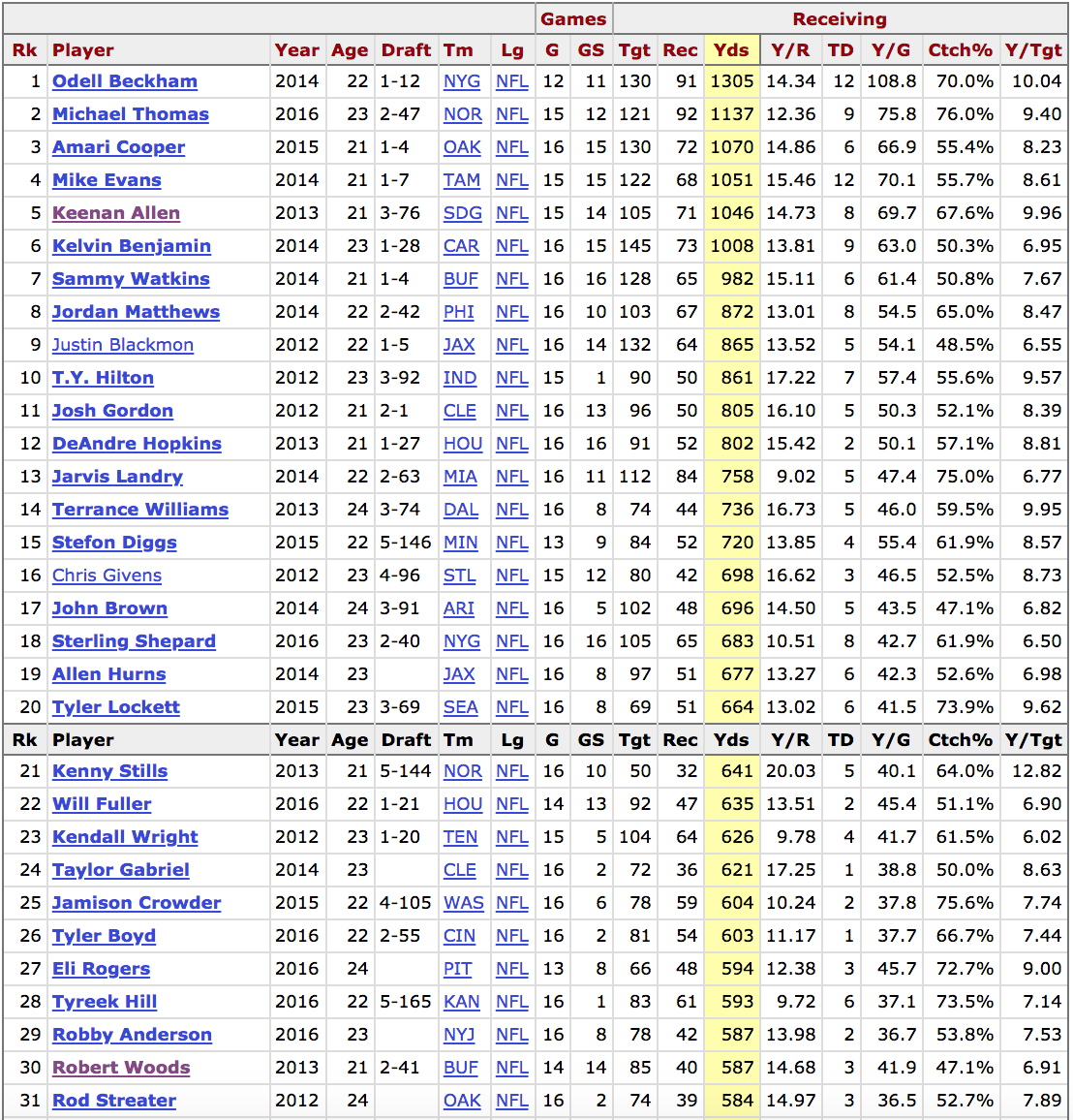Production Patterns: Past Draft Classes – 2017
The 2019 NFL draft is coming and I’m breaking down past wide receiver classes, looking for patterns in production from 2012-2017. Instead of my usual attempts and broad scale context and examples, instead I want to look more specifically and conversationally. This will give us a six-year sample of what wide receiver production looked like, without having to justify every sentence with a graph.
We’re making a model but with words.
So let’s check in on the third season that was, compared to the three or four years before it, part of a wide receiver recession.
2017
First up, let’s admit the recession we all remember, or at least the one I thought we’d been through, wasn’t that bad. Depending on who you think of as hits and misses, the number of good wide receivers didn’t fluctuate much through 2012-2016. While we saw a lot of first rounders go down (maybe due to over drafting, maybe to injury) we also saw that this was true in a different way for the 2012 class.
As a quick measure, and to put one of our patterns to use, players who get over 600 receiving yards in their rookie season more often go on to have good careers then not. Seven out of the 25 rookies (28%) to do that since 2012 were drafted during my so-called “recession” years.
[am4show have=’g1;’ guest_error=’sub_message’ user_error=’sub_message’ ]

Table from Pro Football Reference.
Heck, two of the six rookies (30%) to go over 1,000 yards were from 2015-2016.
2017 is no different in that there are some good players we definitely want on our dynasty teams, and being able to see the long view from 2012, we can imagine it will eventually work out in a similar way.

Corey Davis has yet to finish in the top 24 in PPR scoring, though in 2018 his usage and target share itself was a positive indication on a struggling team. In the meantime, JuJu Smith-Schuster has finished in the top 24 both years and the top 12 once. Kenny Golladay is the only other player to have a top-24 season while Chris Godwin and Cooper Kupp have both shown they are talented players at the next level with plenty of dynasty value.
All of these players have positive production profiles based on what we have seen, whether it’s from the age of their breakout to the heights of their college dominance.
Davis also offers us some more context for a player like Tyler Boyd. Both were very productive and have failed to get off the ground as quickly as others in their respective classes. That suggests a conference or level-of-competition adjustment could also be very useful when assessing player production. On the other hand, Kupp, who also played at a lower level of competition, has fairly standard breakout numbers and if we adjusted for his conference, it might well have made him look less interesting.
The fact Kupp has yet to finish in the top 24, I think most would agree, has more to do with injuries than talent or opportunity

Compared to the average Dominator of top-24 NFL players, the right names stand out: Davis, Smith-Schuster, Golladay, Godwin, and Kupp.
The Exceptions
There have been none in the 2017 class. The more productive players have generally been better than the less productive players.
“What about Zay Jones?” Someone out there must be saying. Well, he’s close enough to the average that his production didn’t look terrible as we see above. But any examination of his college numbers uncovered a shocking amount of inefficiency at the college level and that has followed him into the NFL.
Mike Williams always looked to me like a great prospect who suffered a terrible injury and returned a lesser player at age 21. He seemed like a risk in the first round and that has proven true – although I’m hopeful his 2018 season is a sign he has turned a corner. Josh Ross, speed or no speed, was very underproductive in both college and the NFL.

Based on his landing spot, I had hoped Taywan Taylor could prove to be a value in the second round of rookie drafts. But despite showing some promise, he has not yet been able to put it all together in the NFL. Carlos Henderson, Amara Darboh and Ardarius Stewart look like long shots and so far that has proven true.
And there’s the rub. Despite seeing productive metrics be successful at isolating good players, everything is relative. As we know, players have broken out with less impressive profiles and have failed to with great ones. So, John Ross in the late first round would have been a good pick, as was Taywan Taylor in the second.
Production has never ranked draft picks well, as we have seen, but it’s very useful to identify players in the same range with a higher or lower likelihood of being fantasy-relevant in the NFL.
Just Yards: Where the Cream Rises
Looking back always elicits a little outrage. After all, hindsight lets us be as accurate as we want, or wish, we could have been. But JuJu Smith-Schuster always looked like a great prospect.

I had to adjust his breakout age to 18 (technically 17 based on when I calculate it from) and there were just no red flags on his profile. On top of that, players like Golladay were in situations you’d expect elevated market share with talent. I won’t lie and say I wasn’t worried about Smith-Schuster being drafted behind Antonio Brown but looking back, the only player I had above him was Davis.
It’s a mistake I will likely make again, however, because draft capital matters. But very productive players are always an easy reach for me compared to those like Ross or Williams. That’s just how I play it.
Production had a good year in 2017 – maybe enough to make up for 2016 if Davis can get right, but we’ll see.
Next up
Next would be 2018, but two years of “seeing it” for the 2017 class playing out was already pushing it. So, I’m moving right along to examine the current rookie class for 2019.
See you there and thanks again for checking out this series!
[/am4show]
- Peter Howard: Dynasty Fantasy Football Superflex Rankings Explained - March 6, 2024
- Dynasty Target and Regression Trends: Week 15 - December 23, 2023
- Dynasty Target and Regression Trends: Week 14 - December 16, 2023


































































